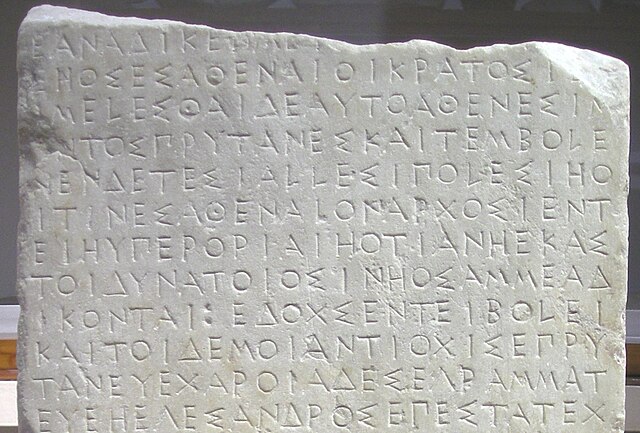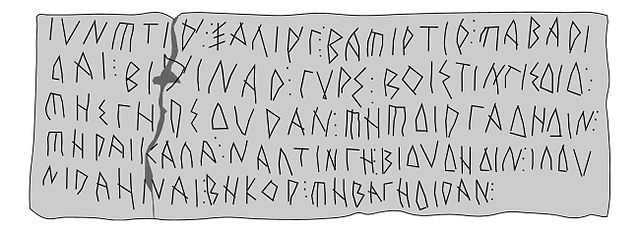Sampi is an archaic letter of the Greek alphabet. It was used as an addition to the classical 24-letter alphabet in some eastern Ionic dialects of ancient Greek in the 6th and 5th centuries BC, to denote some type of a sibilant sound, probably or, and was abandoned when the sound disappeared from Greek.
The Nessus amphora, with the name "ΝΕΤΟΣ" (possibly obliterating earlier "ΝΕͲΟΣ") on the right
Graeco-Iberian lead plaque from la Serreta (Alcoi), showing the Iberian form of sampi. The first word is ΙΥΝͲΤΙΡ̓, iunstir
Coin of king Kanishka, with the inscription ÞΑΟΝΑΝΟÞΑΟ ΚΑΝΗÞΚΙ ΚΟÞΑΝΟ ("King of Kings [cf. Persian "Shahanshah"], Kanishka the Kushan"), using Bactrian "þ" for š.
Many local variants of the Greek alphabet were employed in ancient Greece during the archaic and early classical periods, until around 400 BC, when they were replaced by the classical 24-letter alphabet that is the standard today. All forms of the Greek alphabet were originally based on the shared inventory of the 22 symbols of the Phoenician alphabet, with the exception of the letter Samekh, whose Greek counterpart Xi (Ξ) was used only in a sub-group of Greek alphabets, and with the common addition of Upsilon (Υ) for the vowel. The local, so-called epichoric, alphabets differed in many ways: in the use of the consonant symbols Χ, Φ and Ψ; in the use of the innovative long vowel letters, in the absence or presence of Η in its original consonant function ; in the use or non-use of certain archaic letters ; and in many details of the individual shapes of each letter. The system now familiar as the standard 24-letter Greek alphabet was originally the regional variant of the Ionian cities in Anatolia. It was officially adopted in Athens in 403 BC and in most of the rest of the Greek world by the middle of the 4th century BC.

The phrase Ἔδοξεν τῇ Βουλῇ καὶ τῷ Δήμῳ ("The Council and the Citizens have decided") is typically spelled Εδοχσεν τει Βολει και τοι Δεμοι in inscriptions of the Athenian democracy prior to 403 BC.
Corinthian black-figure column-krater, showing the name ΗΙΠΠΟΛΥΤΟΣ (Hippolytos) in Corinthian script.



![Coin of king Kanishka, with the inscription ÞΑΟΝΑΝΟÞΑΟ ΚΑΝΗÞΚΙ ΚΟÞΑΝΟ ("King of Kings [cf. Persian "Shahanshah"], Kanishka the Kushan"), using Bactria](https://upload.wikimedia.org/wikipedia/commons/thumb/a/a6/KanishkaCoin3.JPG/640px-KanishkaCoin3.JPG)

